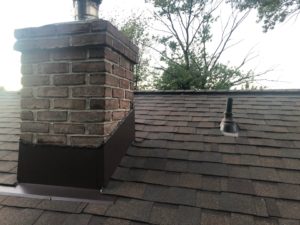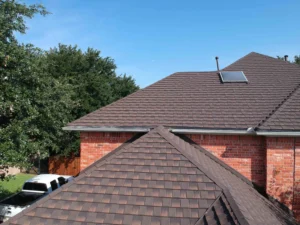If you have ever experienced water seeping into walls and other vulnerable areas from the roof, you’re probably familiar with moisture damage, mold growth, and structural deterioration. These issues not only compromise the integrity of your home but can also lead to significant repair costs and health problems associated with mold exposure. The solution to preventing these problems lies in the installation of high-quality roof flashing.
What is Roof Flashing?
Roof flashing is a critical component in the roofing system of your home, ensuring water does not penetrate and cause damage. This guide emphasizes why roof flashing is important and introduces homeowners to its fundamental aspects.
The Basics of Roof Flashing
Roof flashing is designed to direct water away from critical areas of your roof, protecting the home from water damage. Its placement varies but is commonly found around chimneys, vents, and where the roof plane meets a vertical wall.
Types of Roof Flashing
There are several types of roof flashing, each serving a specific purpose:
- Step Flashing: Protects the junction between the roof deck and walls.
- Counter Flashing: Covers step flashing for added protection against water.
- Valley Flashing: Shields the roof valleys where two roof planes meet.
- Apron Flashing: Guards against water infiltration at the base of structures like chimneys.
- Drip Edge Flashing: Installed at the edge of the roof to direct water away from the fascia.
These types highlight the diversity of roof flashing materials, from metal flashing to copper roof flashing, each chosen for its durability and effectiveness.
Signs of Roof Flashing Damage
A roof flashing leak can manifest in water stains on ceilings or walls, indicating that some component of the roof’s flashing system has failed. Regular inspections can help identify these issues early.
The Role of Roof Flashing in Preventing Water Damage
Properly installed flashing is vital for directing water away from the roof deck and into gutters. This is particularly crucial in roof valleys and at roof penetrations, where water is most likely to collect.
Installing Roof Flashing: A Professional’s Job
The installation of roof flashing, such as continuous flashing or valley flashing, requires precision and understanding of water flow on a roof plane. Professional roofers are equipped to handle these complexities, ensuring that each piece of flashing is correctly integrated into the roofing system.
Maintenance Tips for Roof Flashing
Regular maintenance, including clearing debris from valleys and inspecting for signs of wear, can extend the lifespan of your roof flashing. Copper roof flashing, for instance, is known for its longevity but still requires inspection to ensure it remains effective.
DIY vs. Professional Repair: Understanding Your Limits
While some aspects of flashing maintenance, like cleaning gutters, are within the homeowner’s ability, repairs, especially those involving roof penetration or replacement of metal flashing, should be left to professionals.
Choosing the Right Material for Your Roof Flashing
When selecting roof flashing materials, consider factors such as durability, compatibility with your roof type, and aesthetic preferences. Copper roof flashing and metal flashing are popular for their durability and effectiveness.
The Cost of Roof Flashing Installation and Repair
The investment in roof flashing installation or repair can vary widely based on the materials used and the complexity of the job. Copper roof flashing, for example, may be more expensive upfront but offers longer-lasting protection.
Innovations in Roof Flashing Technology
Advancements in materials and installation techniques continue to improve the effectiveness of roof flashing. Homeowners should stay informed about these innovations to make educated decisions about their roofing needs.
Ensuring the Longevity of Your Roof
Regular maintenance and timely repairs of your roof’s flashing are essential to protecting your home from water damage. By understanding the types of roof flashing and their specific roles, homeowners can ensure their roofing system remains effective for years to come.
Frequently Asked Questions
What is wall flashing?
Wall flashing is a type of roof flashing that’s specifically designed to prevent water from penetrating the space where the roof meets a vertical wall. This kind of flashing is crucial in areas such as sidewalls, dormers, or any other points where the roof intersects with vertical structures. Wall flashing works by creating a waterproof barrier that directs water away from these intersections, ensuring that moisture does not seep into the walls, which could lead to water damage or mold growth inside the structure.
What is Drip Edge Flashing?
Drip edge flashing is a metal strip installed at the edges of the roof, particularly at the eaves and rake edges. Its primary function is to guide water away from the fascia and protect the underlying roof components. By extending slightly beyond the edge of the roof, drip edge flashing prevents water from dripping directly onto the underlying materials, instead directing it into the gutters. This helps to prevent water damage along the roof’s edge and reduces the risk of rot in the fascia boards and roof deck.
What makes roof flashing important?
Roof flashing is important because it serves as the first line of defense against water infiltration at the roof’s most vulnerable points – including valleys, chimneys, eaves, and around skylights or vent pipes. Properly installed flashing prevents water from seeping into these critical areas, thereby protecting the structural integrity of the roof and the interior of the home. Without effective flashing, buildings are at a higher risk for moisture damage, mold growth, and the deterioration of roof materials. In essence, roof flashing is vital for maintaining the longevity and safety of the entire roofing system and the home it covers.
Final Thoughts
Regular inspections and maintenance of your roof flashing can prevent costly repairs and extend the life of your roof. When in doubt, consult with a professional roofer to address any concerns or potential issues with your roof’s flashing system.






